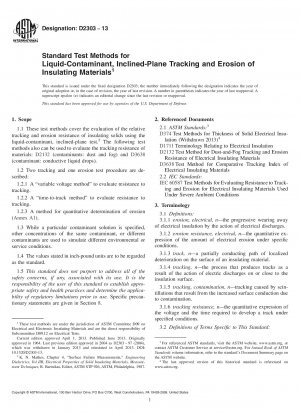ASTM D2303-13
Standard Test Methods for Liquid-Contaminant, Inclined-Plane Tracking and Erosion of Insulating Materials
- Standard No.
- ASTM D2303-13
- Release Date
- 2013
- Published By
- American Society for Testing and Materials (ASTM)
- Status
- Replace By
- ASTM D2303-20
- Latest
- ASTM D2303-20e1
- Scope
4.1 These test methods differentiate among solid electrical insulating materials on the basis of their resistance to the action of voltage stresses along the surface of the solid when wet with an ionizable, electrically conductive liquid contaminant.
4.2 These test methods quantitatively evaluate, in a relative manner, the effects upon an insulating material resulting from the action of electrical discharges upon a material surface. The effects are similar to those that may occur in service under the influence of dirt combined with moisture condensed from the atmosphere.
4.2.1 In the field, the conditions resulting in electrical discharges occur sporadically. Degradation, often in the form of a conducting “track,” develops very slowly until it ultimately bridges the space between conductors thus causing complete electrical breakdown.
4.2.2 In these test methods, the conducting liquid contaminant is continuously supplied at an optimum rate to the surface of a test specimen in such a fashion that essentially continuous electrical discharge can be maintained.
4.3 The time-to-track a 1-in. (25-mm) distance at a specified voltage between electrodes separated 2 in. (50 mm) has also been found useful in categorizing insulating materials for indoor and protected outdoor applications, such as metal-clad switchgear.
4.4 The initial tracking voltage has been found useful for evaluating insulating materials to be used at high voltages or outdoors and unprotected, as well as for establishing (see 10.1) the test voltage for the time-to-track test.
4.5 In service many types of contamination cause tracking and erosion of different materials to different degrees. This method recognizes the importance of such variability and suggests the use of special test solutions to meet specific service needs. For example, an ionic contaminant containing, in addition, a carbonaceous component such as sugar is substituted to cause tracking on very resistant materials like polymethylmethacrylate. Such contamination is considered representative of some severe industrial environments. In this case, the time-to-track technique is used, since time is required to decompose the contaminant solution and build up conducting residues on the sample surface.
4.6 Very track-resistant materials, such as polymethylmethacrylate, typically erodes rather than track under more usual contaminant conditions in service. The use of this method for measuring erosion is consequently important. For erosion studies, only tests as a function of time at constant voltage are usefu......
ASTM D2303-13 Referenced Document
- ASTM D1711 Standard Terminology Relating to Electrical Insulation
- ASTM D2132 Standard Test Method for Dust-and-Fog Tracking and Erosion Resistance of Electrical Insulating Materials
- ASTM D3638 Standard Test Method for Comparative Tracking Index of Electrical Insulating Materials
- ASTM D374 Standard Test Methods for Thickness of Solid Electrical Insulation
ASTM D2303-13 history
- 2020 ASTM D2303-20e1 Standard Test Methods for Liquid-Contaminant, Inclined-Plane Tracking and Erosion of Insulating Materials
- 2020 ASTM D2303-20 Standard Test Methods for Liquid-Contaminant, Inclined-Plane Tracking and Erosion of Insulating Materials
- 2013 ASTM D2303-13 Standard Test Methods for Liquid-Contaminant, Inclined-Plane Tracking and Erosion of Insulating Materials
- 1997 ASTM D2303-97(2004) Standard Test Methods for Liquid-Contaminant, Inclined-Plane Tracking and Erosion of Insulating Materials
- 1997 ASTM D2303-97 Standard Test Methods for Liquid-Contaminant, Inclined-Plane Tracking and Erosion of Insulating Materials

Copyright ©2024 All Rights Reserved